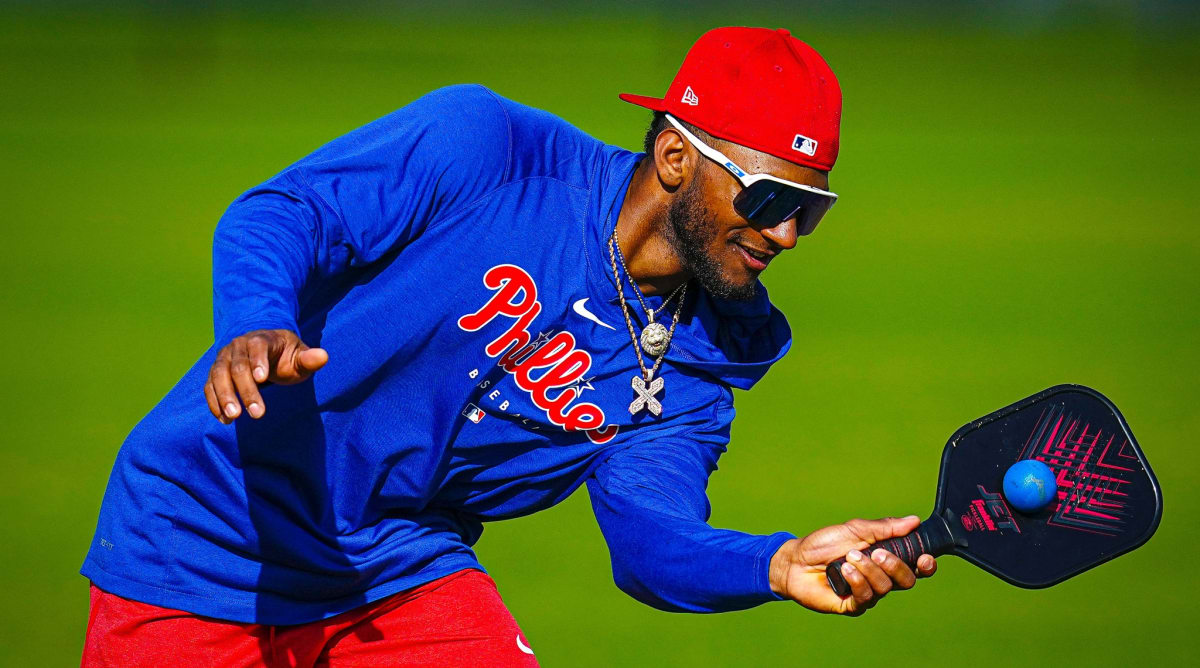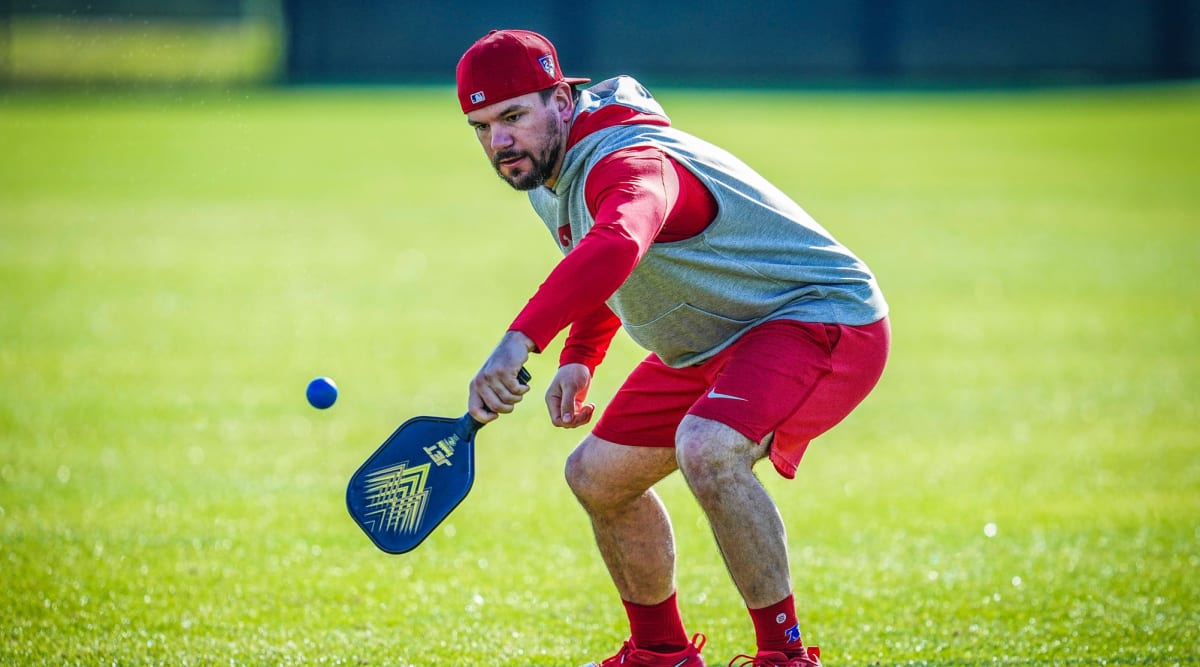Second baseman Bryson Stott has missed his third consecutive flyball when right fielder Nick Castellanos finally loses patience. The morning is still cool, but these four Philadelphia Phillies are coated in sweat as they sprint and dive across a back field at spring training Sunday, working toward what they hope will be a third straight playoff appearance. Their bats and gloves are back in the clubhouse, though. They are armed only with pickleball paddles and half a dozen balls.
Castellanos invokes Stott’s double play partner. “If I was Trea [Turner], I’d be yelling at you!” he chirps.
Stott makes the next play, and they eventually beat their opponents, designated hitter Kyle Schwarber and utilityman Weston Wilson. “Good boy,” Castellanos congratulates Stott. “F---,” Schwarber laments.
Related: MLB 2024 Spring Training Preview
They rotate—center fielder Johan Rojas, who was refereeing, takes over for Wilson—and play again. At one point someone wonders when the players are supposed to gather to stretch. “Do you need stretch after this?” Castellanos pants.
After Castellanos and Stott take round two, they all tramp back into the clubhouse to begin what might be more traditionally considered baseball activities. But outfield coach Paco Figueroa believes this modified version of pickleball—called Pacoball, a name coined by The Athletic’s Matt Gelb—is, too.
“It helps with a lot of things,” Figueroa says. “Moving different directions, agility, you gotta drop to get the ball, go in to hit it. I envision our three outfielders [playing across from another three outfielders, and doing] a lot of communicating—‘I got it, I got it’—and you’re switching positions.” He smiles. “And a lot of it is competitiveness. The more you can compete, the better it is.”

Philadelphia Phillies
The Association of Pickleball Professionals estimated last year that 48.3 million American adults had played the game, a mashup of Ping-Pong, tennis and badminton, at least once in the past year, making it the fastest-growing sport in the country for the third consecutive year. Among them is Figueroa, who this winter noticed the connections between his job and his hobby.
When he arrived at camp this spring, he asked the grounds crew to find an area where they could be out of the way and mess up the grass, then mark off four squares of 30 feet by 30 feet. He and the staffers played a few inaugural games of his modified version (catcher Garrett Stubbs calls it “a combination of foursquare, squash and pickleball”), and then he introduced it to his outfielders.
“I’ve never played pickleball,” says corner outfielder Jake Cave. “And I was actually making fun of it a couple days ago, saying it was, like, an old person game, because my dad lives in The Villages [which bills itself as ‘Florida’s friendliest active adult 55+ retirement community’] and that’s the most popular game there. I was making fun of it. But then I went out there.” Cave says he is going to call his father and apologize.
The rules change as Figueroa chooses different elements to emphasize. They use a racquetball instead of a wiffleball because it’s harder, and there is no net. Players use their nondominant hands, in part so they don’t smash a ball so hard they kill a teammate, but mostly so they can practice using their glove hand. Figueroa recently decided that on a tough play, a player is allowed to lob the ball to his partner, who then hits it to the opponents, as long as they communicate. (No set pieces, though.) Eventually Figueroa wants to keep track of records by individual player and by team. The players are way ahead of him: Center fielder Cristian Pache is already tracking statistics. Coincidentally, those statistics list Pache as the winningest player.
Pache does indeed get a lot of votes for best player, but teammates also praise Castellanos. He’s not so sure. Who’s the best player?
“Too early to tell,” he says.
Who’s the worst?
“Too early to tell.”
It’s not too early to identify a crossover with his outfield play, though. “I have moments where I make some really good plays,” he says. “But then I also have moments where I do some stupid plays, like forget to let it bounce the second time.” He grins and adds that, just like in baseball, “All my mistakes are stupid and losing focus. But sometimes I flash the paddle.”
Schwarber is roundly estimated to be the worst player, including by himself, which drives him crazy, he says, because he is good at regular pickleball. “I’m not very coordinated with my off-hand, which is a good thing to know,” he says. (And indeed, when they briefly switch to playing with their dominant hands, Schwarber becomes much more competitive.)

Philadelphia Phillies
Figueroa believes strongly in the benefits of quickness and confidence. He refers to the area immediately surrounding an outfielder as “the five-foot circle,” sometimes going as far as to draw one on the ground, and encourages them to get out of the circle as fast as possible. He spends the first few weeks of spring training working with outfielders on a half-sized field, moving them in toward the infield and limiting how much time they have to react to the ball off the bat. They take ground balls the way infielders usually do, starting on their knees at just a few feet away and working backward. When they eventually move to full distance, the game feels slower. And if he sees “guys that are panicking with a ground ball,” he says, he moves them back to their knees and starts over.
“What I like to teach is, as you see defenders, the best ones are aggressive through the ball,” he says. “You can visualize it. The ones that are insecure, they break down early because they’re worried about not messing up, and then they tense up their shoulder and they [pull back]. A lot of people that have good hands are good Ping-Pong players.” He demonstrates the way the quick wrists and tight follow-through can help scoop a ball. “That little move, it doesn’t have to be an aggressive one, but it’s a confident move,” he says. “So that’s basically what you’re creating. You’re gonna be running and then it’s gonna be, Oh s---. When you feel Oh s---, be aggressive.”
(On another field, infield coach Bobby Dickerson is training his infielders like outfielders, finishing every day of ground balls with a few pop-ups behind them. “He talks about it, ‘You’re a 360 [degree] player, not a 180 [degree] player,’” Figueroa says.)
Stott, as an infielder, is not really invited to the sessions, but he thought they looked fun, so he joined them on Sunday, and he plans to recruit Turner to join him. Stott dismisses the idea that he lacks technical skill, emphasizing instead his winner’s heart.
“I won two games,” Stott points out. “It’s my first day. They’ve been playing for three weeks.”
O.K., so what’s his scouting report on the rest of them? Whom does he think is the best?
“I don’t know if any of them are good,” he says. “Me and Trea are gonna win every game we play. You’ll see.”







